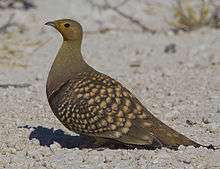Namaqua sandgrouse
The Namaqua sandgrouse (Pterocles namaqua), is a species of ground-dwelling bird in the sandgrouse family. It is found in arid regions of south-western Africa.
| Namaqua sandgrouse | |
|---|---|
 | |
| Male | |
 | |
| Female | |
| Scientific classification | |
| Kingdom: | Animalia |
| Phylum: | Chordata |
| Class: | Aves |
| Order: | Pterocliformes |
| Family: | Pteroclidae |
| Genus: | Pterocles |
| Species: | P. namaqua |
| Binomial name | |
| Pterocles namaqua (Gmelin, 1789) | |
Description
The sandgrouse is a medium-sized bird with a plump body, small head and short legs. It grows to a length of about 28 centimetres (11 in). The male has an orangish buff head, throat and chest delineated by a conspicuous narrow band of white and dark brown. The back and wings are mottled brown with large white specks and there are two long black filaments extending from the olive-brown tail. The colouring of the female and juvenile is more cryptic being generally various shades of brown patterned with white specks.[2] It could be confused with the double-banded sandgrouse (Pterocles bicinctus) and Burchell's sandgrouse (Pterocles burchelli), which share the same range.
Distribution and habitat
The Namaqua sandgrouse can be found in various arid parts of South Africa and its neighbouring lands. It is common in the Kalahari Desert, the Nama Karoo (in central and western South Africa), and in parts of the Western Cape. In addition, it is also found in Namibia (especially in the Namib Desert), Zimbabwe, Botswana and Angola.
It favours deserts and other arid areas. In order to survive, this bird needs only seeds, some gravel, and easy access to some sort of fresh water source. Their habitat usually has rough vegetation and tussock-type grasses. [3]
Behaviour
Outside the breeding season, the sandgrouse are gregarious. The birds converge on watering holes in the early morning and several dozens or even hundreds of individuals may congregate in one place. They also tend to spend the night in groups, congregating about an hour before dusk. They split up during the day into much smaller groups to feed.
Feeding
Their principal diet is seeds but they also eat leaves, flowers, small fruit, insects and molluscs.[2] They forage by exploring loose soil with their beaks and flicking it away sideways.[4]
Breeding
Breeding takes place at any time of the year and is dependent on rainfall. Usually the nests are solitary but sometimes several pairs of birds choose sites near each other. The nest is a scrape in the earth, scantily lined with dried plant material. Two or three pinkish-grey eggs with brown markings are laid over the course of a few days. Incubation starts after the last egg has been laid and lasts about 22 days. The female does the incubation by day and the male does a longer shift at night, starting about two hours before sunset and finishing two hours after dawn.[5] The chicks are precocial and able to leave the nest on the day they are hatched. The male brings them water absorbed on the specially adapted feathers of his breast. The chicks grow rapidly; they are fully feathered at three weeks and able to fly at six.
Status and threats
The species is common within its range and is considered to be of Least Concern by the IUCN Red List of Threatened Species.[1] The birds are at risk of predation by mongooses while they are young. Sheep farmers kill birds of prey and jackals to protect their flocks and this may have resulted in an increase in the mongoose population and consequently a diminution in the number of sandgrouse chicks that survive.[2] Other predators that prey on the Namaqua sandgrouse include the booted eagle (Aquila pennatus), the tawny eagle (Aquila rapax), the lanner falcon (Falco biarmicus) and the peregrine falcon (Falco peregrinus).[4] The Namaqua sandgrouse is a host of the Acanthocephalan intestinal parasite Moniliformis kalahariensis.[6]
References
- BirdLife International (2012). "Pterocles namaqua". IUCN Red List of Threatened Species. 2012. Retrieved 26 November 2013.CS1 maint: ref=harv (link)
- "Ganga namaqua". Oiseaux.net. Retrieved 2012-06-05.
- "Namaqua Sandgrouse {Pterocles namaqua}". www.sa-venues.com. Retrieved 2019-06-10.
- "Pterocles namaqua (Namaqua sandgrouse)". Biodiversity. Retrieved 2012-06-06.
- Lloyd, Penn; Little, Robin M.; Crowe, Timothy M. (2001). "The breeding biology of the Namaqua sandgrouse, Pterocles namaqua ". Journal of African Ornithology. 72 (3–4): 169–178. doi:10.2989/00306520109485313.
- Amin, Omar M.; Heckmann, Richard A.; Halajian, Ali; El-Naggar, Atif; Tavakol, Sareh (2014). "Description of Moniliformis kalahariensis(Acanthocephala: Moniliformidae) from the South African Hedgehog,Atelerix frontalis(Erinaceidae) in South Africa". Comparative Parasitology. 81: 33–43. doi:10.1654/4664.1.
External links
- Namaqua sandgrouse – Species text in The Atlas of Southern African Birds.
